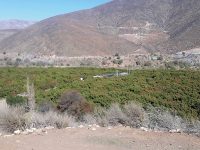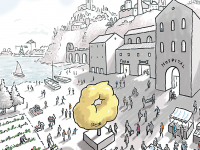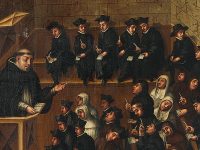Following the thread: the Silk Road in Valencia
Valencia remembers its silk past as the capital of the Silk Road
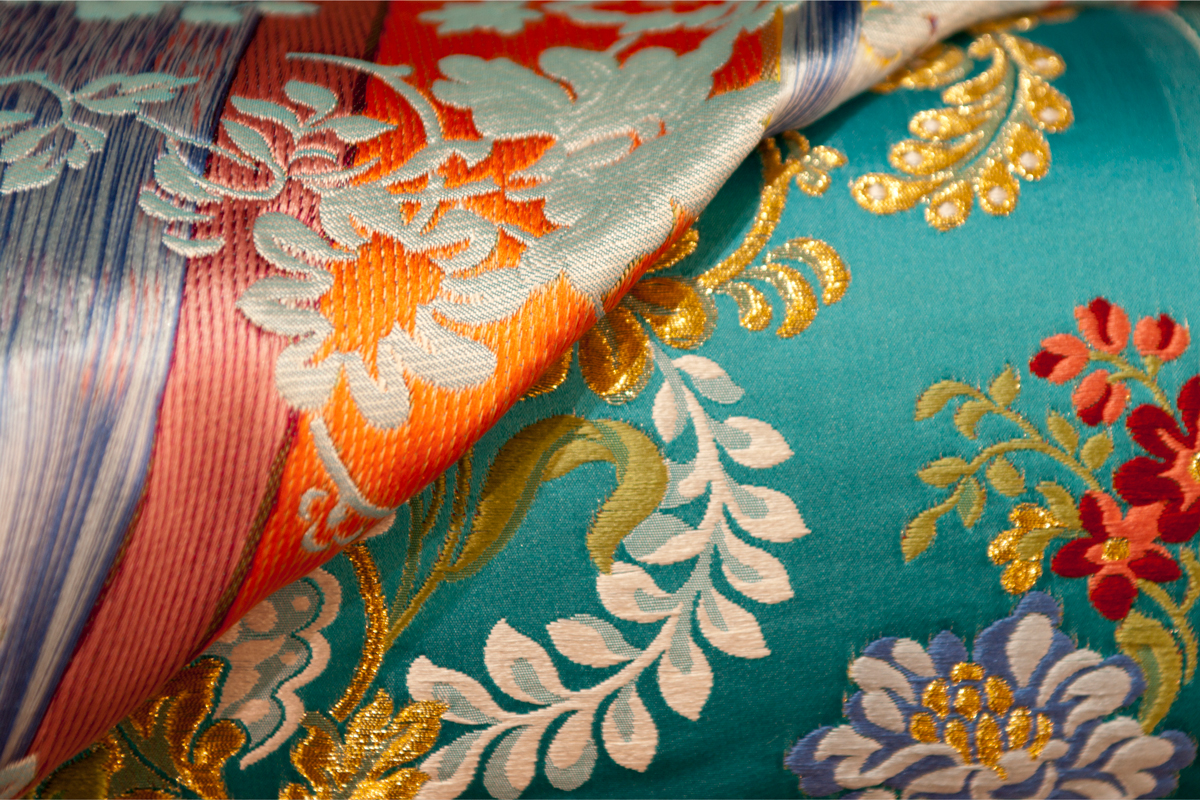
The history of the Valencian Silk Road begins in the fourteenth century. After its arrival with the Muslims, and thanks to the technological contributions of the Genoese, Valencia became a silk export centre from Granada to northern Italy. During those years, Italy significantly developed the silk industry, especially in cities such as Genoa, linking the western silk road with the eastern Mediterranean – Palestine or present-day Lebanon. Thanks to the close relations between Valencia and Genoa, Valencia could improve its silk industry technologically and create the famous neighbourhood of Velluters, whose name comes from the Italian word velluto. The velluters guild was founded in the fifteenth century, specifically in 1479, and soon became the most important trade in the city. The progressive growth of the sector became evident in 1547, when the regional government proclaimed silk to be the «main fruit of the Kingdom» («principal fruyt del dit Regne»).
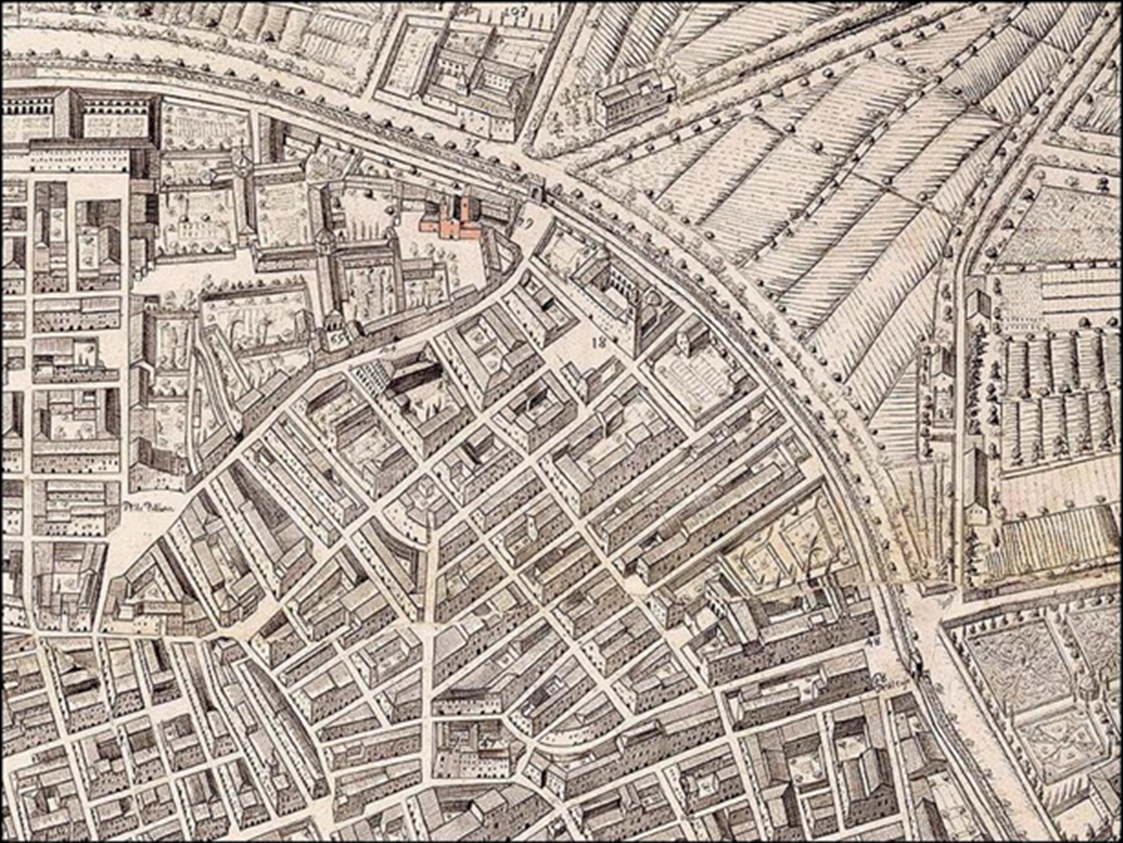
Old map of the Velluters district. / Image provided by Ester Alba
However, it was not until the end of the seventeenth century when Valencia became a major silk production centre, since Toledo was the leading silk producer in Spain until then. During the sixteenth and seventeenth centuries, Valencia was responsible for supplying Toledo with raw material, since the legacy received from our intense relations with Genoa facilitated the spread of mulberry cultivation. In this way, in the sixteenth century Valencia became the most important centre for the production of silk fibre in Spain. At the end of the seventeenth century the silk industry in Toledo declined and Valencia, taking advantage of the large quantity of raw material, began to develop its own silk industry, with the eighteenth century becoming the period of maximum splendour of Valencian silk. In fact, in 1686 King Charles II granted the privilege to the velluters guild, allowing its conversion into the College of High Silk Art in order to create a structure that homogenised production. This laid the foundations for its expansion during the following century.
The silk road was important not only because of the trade, but also because of the constant exchange that took place during the trips. An exchange of other products that arrived to Valencia, such as porcelain or tea, and an exchange of the knowledge and ideas brought by scientists, priests, adventurers, and intellectuals. Thus, parallel to the commercial exchange there was also a cultural and scientific exchange that enriched every place it passed through.
2016, when it all started again
In 2013, Valencian Professor Aurora Pedro was elected vice-president of the UNWTO Affiliate Members Committee, an organisation with which she had collaborated for many years. In a meeting of the UNWTO Silk Road Programme, this professor in the Faculty of Economics asked for Spain’s entry on behalf of the University of Valencia. A few weeks later, the request was granted. The importance of silk in Spain, but especially in the Valencian region and the city of Valencia, was the motivation behind this request. It was necessary to recover and promote the historical and cultural heritage associated with this activity and to reclaim the centuries-old role it played in Valencia’s economy and society.
«Thanks to Valencia’s historical importance in silk production, Spain became the 32nd participant in the UNWTO Silk Road Programme»
This is how, thanks to Valencia’s historical importance in silk production, Spain became the 32nd participant in the UNWTO Silk Road Programme. Finally, in 2016 the city was declared the western capital of the Silk Road by UNESCO, based on a report presented by the University of Valencia, the only Spanish university that is part of the UNWTO’s Board of Affiliate Members. Being part of the Silk Road, and being the western capital, implies being the centre of all the activities that take place within this framework, allowing us to build a tourist resource and highlight the rich Valencian heritage related to the silk industry.
Guillermo Palao, vice-principal for Internationalization and Cooperation at the University of Valencia, says that being appointed as Silk Capital means for the city and its surroundings «an important recognition, as well as an excellent opportunity, from the perspective of its international projection and the recovery of especially significant elements of our history and traditions». Palao points out that 2016 was important for the University of Valencia because it represented the start-up of the project, as well as the establishment of the institutional structure that had to coordinate the actions within the UNWTO Silk Road Programme. The Faculty of Economics and the Faculty of Geography and History of the University of Valencia, the UNESCO Chair of the University and the Confucius Institute participate in this structure, with the support of the Valencia Tourism Agency.
Together with the Valencia Tourism Agency, the University of Valencia signed a collaboration protocol in 2015 to coordinate efforts in the promotion of the culture and heritage of Valencian society. A commitment that promotes cultural and sustainable tourism as a means of reclaiming and supporting traditions, history, and art, as well as cultural, natural and intangible heritage with silk as a common element. The aim is to develop the activities and objectives proposed by the UNWTO Silk Road Programme, including efforts to keep ethnographic memory alive and encourage the flow of ideas between regions.
The collaboration of this wide range of institutions allows the University of Valencia to work on a strategic project for the city, as well as to carry out interdisciplinary research with all the participating institutions to break the usual trend of isolated work areas. Likewise, it is an opportunity to create alliances with universities in the Silk Road framework, from Portugal to Japan. A network with over 80 universities from 20 different countries.
«Being appointed as Silk Capital means an important recognition for Valencia and its surroundings»
Some of the activities highlighted by the vice-rector are organising three international conferences, developing around ten conferences and half a dozen exhibitions, gastronomic and musical festivals, or preparing the catalogue and atlas of Silk Road heritage in the region of Valencia, as well as several workshops and a thematic internship programme for students. All these events have aimed to reclaim Valencia’s position in the silk market and have involved up to 42 countries. «In short, 2016 was a vibrant and exciting year, in which the potential of the University of Valencia in relation to the studies of the Silk Road was brought to the fore», concludes Palao.
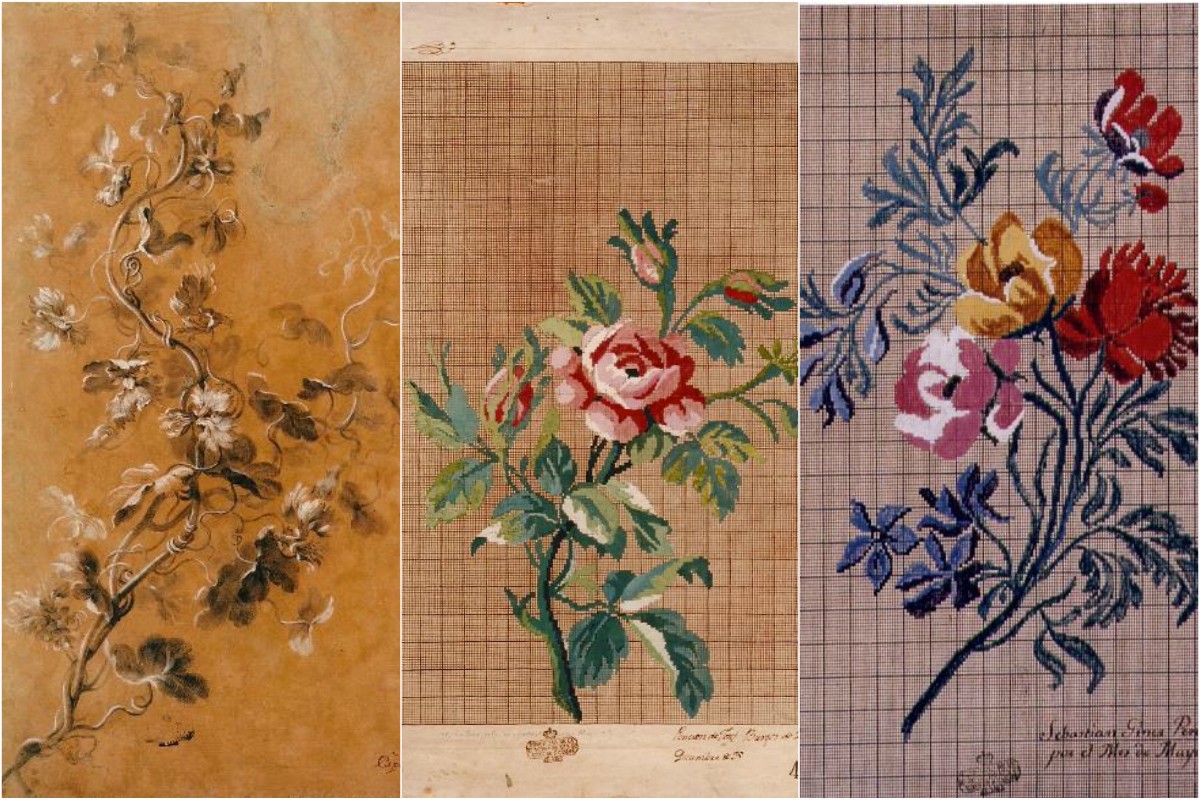
Capuchin Poor Clares, by Benito Espinós; Bouquet of roses, by José Burgos; and Print sample, by Sebastián Giner. / Images provided by Ester Alba
Touristic and cultural interest
Guillermo Palao explains that 2017 began with the organisation of the first Silk Road Meeting, in which researchers from all areas participated, «allowing the consolidation of this policy in our institution and where the importance of deepening collaboration with other institutions and entities became evident». He continues, «Similarly, the lines of action were defined, incorporating others apart from the initial ones, developed by researchers at our university in relation to the Silk Road, such as studies in Education, Social and Health Sciences, Cooperation for Development, Law, Philology, Literature, or even Nutrition and Gastronomy». Several initiatives are born out of this meeting, such as the bank of ideas, where experts on the Silk Road from the University of Valencia design research projects and develop activities throughout 2017. The II Silk Road Meeting will take place in the Rectorate Building of the University of Valencia on 15 December.
An international course on tourism and the Silk Road has also been developed as part of the Silk Road Action Plan. This is the UNWTO Silk Road Training and Capacity Building Programme, led by Professor Aurora Pedro. According to Pedro, «this course has allowed representatives from different countries to meet for the first time in order to receive training on aspects relevant to transnational tourism development». The first edition of the course focused on two areas: the Mediterranean and Central Asian countries. This collaboration and cooperation can be of great importance, as Professor Pedro points out, not only for the creation of specific products linked to silk, but also for transferring experiences and opportunities to other areas that seek to turn tourism into an important economic activity. Additionally, Palao explains that in 2017 «we have also promoted the EXPERTISE programme, a catalogue of experts from the University of Valencia in different areas of scientific, technical, and cultural knowledge related to the Silk Road initiative».
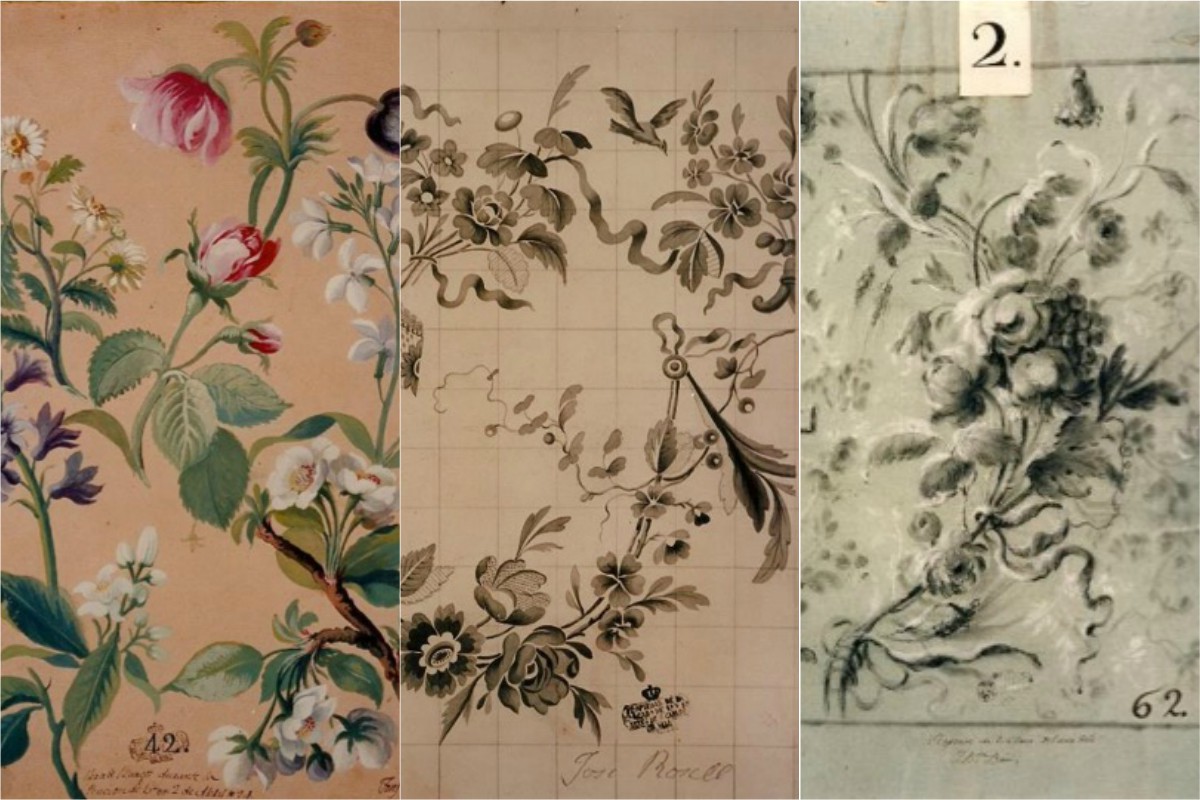
Seven separate branches of daisies, roses, jasmine, lemon balm, almond, tulips, and wild lilacs, by José Burgos; Model for fabric: ornamental flower trimmings, by José Rosell; and Model for fabric: sanctuary curtain, by Juan Bautista Brú / Image provided by Ester Alba
Preserving, recovering, promoting
However, it seems that all the historical splendour of the city of Valencia has now been diluted. «We at the Faculty of Geography and History of the University of Valencia have done a very important job in promoting silk-related history and heritage», explains Ester Alba, dean of the faculty. This art historian stresses that this work is the result of many years of research, consolidated through UNWTO’s recognition and visibility of its researchers. «We have research groups that first studied the production of silk fibre and then the production of silk fabric for years», says Ester Alba. She adds that «the opportunity now is to make all these historical investigations known to the general public».
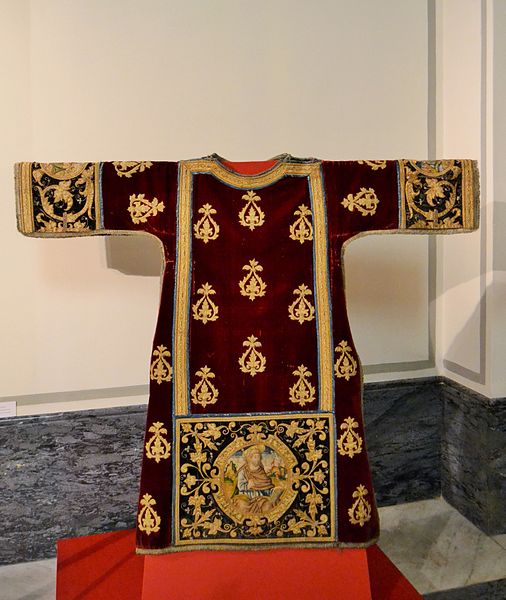
Silk velvet dalmatic, cut and smooth. The inside fabric is crimson red and the lower part and the cuffs are black. Made in the late sixteenth and early seventeenth centuries. Town Historical Museum, Valencia. / Joanbanjo
In the same vein, professors such as Alexandre Bataller, specialist in the study of Valencian sericulture from a cultural and linguistic point of view, state that «this is a unique opportunity to highlight the historical and artistic heritage of Valencia, which until recently has been completely disregarded». In addition, this nomination as the Silk Road Capital can also enrich our culture, as Bataller reminds: «It is the perfect occasion to promote cultural exchange between countries and cultures, but it will all depend on the political and economic interests of the powers involved.»
Ester Alba explains that the University of Valencia made an inventory of the city’s touristic resources and discovered more than 200 elements with a high risk of disappearing: closed to the public, deteriorated… But, in addition, the loss of part of the Valencian heritage affects also landscape, insomuch as the dominant landscape today and since the nineteenth century is dominated by the extensive cultivation of orange groves, while our ancestors could see mulberry groves as well, located on the margins of orchards and roads, especially in the counties of L’Horta de Valencia, La Ribera, and La Vega Baja. Thus, the extension of the mulberry groves forest in the Valencian territory went from being “so large that it could supply Spain and many extensive territories outside”, as described by Gregorio Mayans in 1748 in his letters to José Miguel de Carvajal y Manrique, Spain’s Secretary of State during the reign of Ferdinand VII, to being almost non-existent when the pébrine epidemic – a silkworm disease – coincided with the decline in the silk business. There were also clear losses in the Valencian rural farmhouses, where silkworm was traditionally bred in the upper part of farmlands or in the boundaries between fields; this activity was an important source of income for 80%-90% of Valencian families.
«The landscape today is dominated by orange groves, while our ancestors could see mulberry groves as well»
The traditional trade of silkworker has also been completely lost and there is only one last professional in the city who knows the technique, Vicente Enguídanos. As explained in the website of the College of High Silk Art, «only he knows how to weave silk by hand». Ester Alba considers that this is the consequence of «a lack of protection of craftsmanship against low-cost industrialisation systems» and proposes that institutions should provide financial aid to municipalities that conserve part of this heritage in order to restore it. «Government institutions have to take our heritage seriously. Today, silk heritage lies in the shadow of oblivion», the professor says.
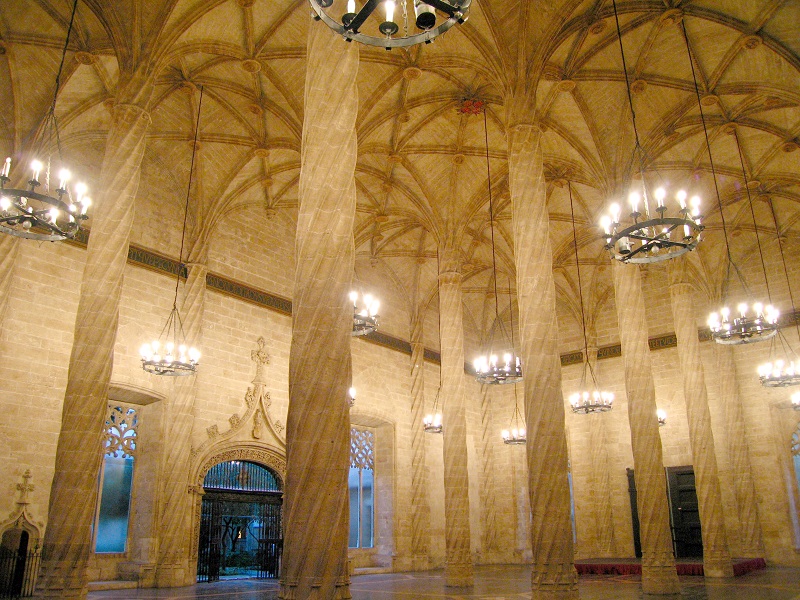
Inside the building of the Llotja de la Seda (silk exchange), also known as the merchant exchange. / Image provided by Ester Alba
Silk architecture
«It is estimated that in the middle of the eighteenth century half of the population of the city of Valencia worked, directly or indirectly, in the silk industry. The history of Valencia is marked by this activity», explains Ricardo Franch, professor of Modern History at the University of Valencia. One only has to look at some of the city’s most outstanding monuments to find the marks. Velluters was the most active district at the time. It housed around 5,000 looms in the eighteenth century. The Llotja, Valencia’s economic heart in those centuries, witnessed the importance of silk. «Valencia is the way it is today thanks to the silk industry of the eighteenth century. It was, along with the fifteenth century, one of the richest in the history of the city», says Professor Franch. Professor Alba clarifies: «We call it “Llotja de la Seda” incorrectly, since it did not acquire this name until the seventeenth century, due to the importance of this trade.»
«Horta Nord, Requena and La Ribera constitute “the silk triangle”»
In this review of the monuments that remind us of the city’s silk past, we must pay attention to the College of High Silk Art, recently restored by a private foundation (it was about to disappear) and transformed into the Silk Museum. «The recovery of the College of High Silk Art is a source of satisfaction for all Valencians, it should be a sort of flagship to make this forgotten and punished district of Velluters visible», explains Alexandre Bataller. It is precisely this institution that has launched a campaign during the 2016-2018 period in which it will carry out activities related to the Road such as exhibitions and collaborations with the University of Valencia, with the organisation of an international congress and the activity of the Scientific Committee, formed by members of the university community such as Ricard Huerta – a professor of artistic education specialising in museums, art and, education – and Ricardo Franch. Another interesting building due to its emblematic character during this period and its good state of conservation is the Palace of Malferit, in Caballeros Street, which is currently the headquarters of L’Iber, the tin soldier museum. Its Hall of Tapestries has been set up and dedicated to the Silk Road. As they explain in the museum, the room shows «scenes of everyday life in China, India, Japan, Persia, Turkey… and many other countries along the legendary Silk Road. Even the Valencian fallas flood the dioramas with bright colours».
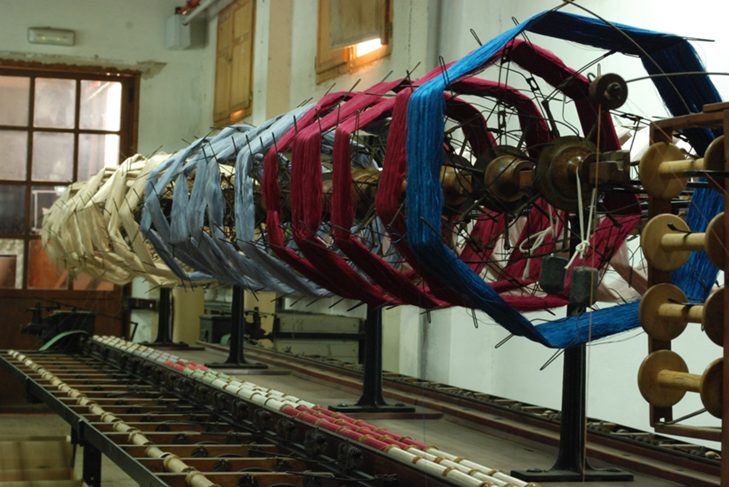
Traditional loom at the Silk Museum of Moncada. / Image provided by Ester Alba
Professor Ester Alba describes what scholars know as «the silk triangle», formed by Horta Nord – especially Montcada, with its Silk Museum, and Vinalesa –, the town of Requena and the counties of La Ribera Alta and La Ribera Baixa. In La Ribera Baixa, Carcaixent and Alzira stand out. At the end of spring, a cocoon and silk market was organised, attracting local and foreign farmers and traders, as documented by the landowner, agrarian leader and populariser Vicent Lassala Santiago Palomares. In addition, the Ribera area is known for its mulberry production systems, different from the rest: extensive cultivation, especially during the eighteenth and nineteenth centuries. This is reflected in significant works such as those by Cavanilles, who in Observaciones sobre la historia natural, geografía, agricultura, población y frutos del Reyno de Valencia (1795) stated that he contemplated «an immense mulberry forest». The Horta Nord area, which was established as a second circle starting from the city of Valencia, includes the relocation of numerous silk factories that were based in Valencia. As for the town of Requena, a strategic location for the exchange of silk products with Castile and Andalusia, it has its own Centre of High Silk Art.
Loving popular culture
«The role of the University of Valencia is essential in recovering this past, because it is not the result of a specific and circumstantial phenomenon such as the appointment as capital of the Silk Road, but rather it is the product of a serious, rigorous, scientific work and of many years of research», explains the dean Ester Alba. She also underlines «the tendency of our governments to look at the world of popular festivals, folklore and traditions from a certain class elitism», and adds that «popular heritage is everybody’s heritage, which is appreciated by regular people. In addition, Valencian festivities have a taste for neighbourhood associationism, they are a ritual of neighbourliness and participation». Therefore, this popular and associative dimension is presented as an «ideal platform» to involve civil society in the conservation of a heritage that is still surviving, but endangered.
Silk fibre production process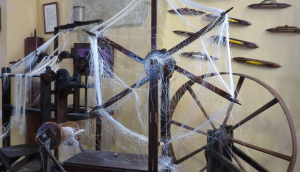 Loom in the Requena Silk Museum. / Image provided by Ester Alba The main activity of the Valencian silk industry from the fifteenth to the end of the seventeenth century was the production of silk fibre, a job that was carried out intensively from March to June. It started by warming silkworm eggs through different methods, like using body heat or the warmth of the sun, but not before a ritual that involved bringing the silkworm eggs to the church to bless them. The enormous dedication required by this process was due to the fact that the income was obtained in June, coinciding with the payment of different leases. Thus, silk harvesting was essential to obtain the income needed to meet the economic demands of peasant families. When June arrived and the worms had already finished the cocoon, the silk was spun. This work, carried out mainly by women, was hard and left its mark on the hands of the peasants who pulled the thread after soaking it in hot water. «The production of silk fibre was a very intense activity carried out in a very specific season, but it was vital for the survival of peasant families», explains Professor Ricardo Franch. |


